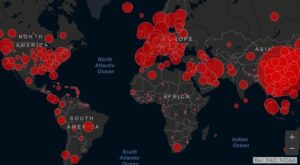Continua la collaborazione tra il liceo linguistico "Cattaneo dall'Aglio" e Redacon tramite la rubrica "Speakeasy" curata direttamente dagli studenti, dell'anno scolastico 2019-2020.
____________________________________________________________________________________________
In some countries governments have started to loosen the restrictions to control the Coronavirus pandemic, which seems to be slowing down, but not everybody agrees with this enforced decision. In fact, some heads of states are afraid that our impatience could cause a second wave of Coronavirus. Peter Beaumont, a journalist from the British newspaper “The Guardian” has written an article about this issue.
The risk he spoke about can become real as it happened with the 1918 influenza pandemic, which killed millions of people during the first wave and then came back in a stronger form in a second wave.
But this is just one of the many examples of pandemics which resurged some months after the end of the first outbreak.
But how and why does this happen? The answer isn’t clear, but scientists are trying to understand it. All we can say is that our social behavior has an enormous impact on the spread of viruses, in particular when a vaccine hasn’t been found yet.
In fact, without a vaccine and with no widespread immunity (also called “herd immunity”) the risk of a second wave is threatening our society. What is happening in Singapore is a perfect example: despite their early handling of the outbreak, the country is noticing a resurgence in infections. The disease came back in cramped dormitory accommodation, where thousands of foreign workers live under inadequate sanitary conditions.
Singapore’s experience has allowed us to witness the disease’s ability to spread.

An increase in cases has been reported also in Germany, where the country moved to loosen restrictions, and in China, which succeeded in bringing the outbreak in Hubei province under control.
Scientists think that a second wave of a strong disease often occurs when our capacity for treatment and isolation becomes exhausted. In fact, people’s frustration has caused protests in many countries.
Generally speaking, the number of immune and susceptible people in a population at the end of the first wave can determine the effect of a potential second wave. Now the main problem is that a vaccine is still months away, and we cannot be sure of the real rate of infection. As a consequence we’re very vulnerable to subsequent waves.
Justin Lessler, an associate professor of epidemiology at Johns Hopkins University believes that epidemics are like fires: when fuel is plentiful, they rage uncontrollably, and when it is scarce, they smoulder slowly.
In this case the fuel is the susceptibility of the people to the pathogen.
The possibility of more waves of the same virus could cause a reduction in the force of the infection, for example thanks to partial or complete immunity, and so there could be fewer risks of contagion, even for those without immunity.
The problem is that we actually don’t know how much fuel the virus can still use.
https://www.theguardian.com/world/2020/apr/20/will-there-be-second-wave-of-coronavirus-
Matilde Conconi e Rossella Ghirelli 4ªQ
****
Ci sarà una seconda ondata di coronavirus?

In alcuni paesi, i governi hanno iniziato ad allentare le misure restrittive prese per controllare la pandemia di coronavirus, che sembra stia rallentando la sua corsa, ma non tutti sono d’accordo con questa decisione. Infatti, alcuni capi di stato temono che la nostra impazienza possa provocare una seconda ondata di contagi. Peter Beaumont, giornalista del quotidiano inglese “The Guardian” ha scritto un articolo proprio su questo tema.
Il rischio di una seconda ondata può diventare reale, come è accaduto nel 1918 durante la pandemia di influenza, che uccise milioni di persone nella prima ondata per poi tornare in una forma più forte durante la seconda ondata.
Ma questo è solo uno dei tanti esempi di pandemie che si manifestano nuovamente qualche mese dopo l’esplosione del primo contagio.
Ma come e perché questo accade? La causa non è chiara, ma gli scienziati stanno cercando una risposta. Quello che sappiamo è che il nostro comportamento sociale ha un impatto enorme sulla diffusione dei virus, specialmente se il vaccino non è ancora stato scoperto.

Infatti, senza un vaccino e senza un’immunità diffusa (anche detta “immunità di gregge”) il rischio di una seconda ondata minaccia la nostra società. Ciò che sta succedendo a Singapore è un esempio lampante: nonostante abbia preso misure precauzionali anticipatamente, il paese sta registrando un aumento dei casi. La malattia è tornata negli stretti e affollati dormitori dove vivono migliaia di lavoratori stranieri in condizioni igieniche inadeguate.
L’esperienza di Singapore ci ha permesso di osservare l’abilità del virus di diffondersi velocemente.
Anche in Germania è stato riportato un aumento dei casi, una volta che il paese aveva allentato le misure restrittive, così come in Cina, paese che era riuscito a portare la diffusione del virus nella provincia dell’Hubei sotto controllo.
Gli scienziati sono concordi nell’affermare che una seconda ondata di una forte malattia spesso arriva quando la nostra capacità di autoisolamento è esaurita.
Infatti, la frustrazione delle persone è sfociata in proteste in molti paesi. In generale, il numero di persone immuni e a rischio alla fine della prima ondata può determinare l’effetto di una potenziale seconda ondata. Ora il problema maggiore è che per avere un vaccino serviranno ancora mesi e non possiamo essere certi del vero numero di contagiati. Di conseguenza siamo molto vulnerabili a ondate successive.
Justin Lesser, professore di epidemiologia all’università Johns Hopkins, crede che le epidemie siano come incendi: quando c’è abbondanza di carburante infuriano, mentre quando il carburante scarseggia, bruciano lentamente. In questo caso il carburante è la suscettibilità della gente al patogeno.
La possibilità di più ondate dello stesso virus può causare una riduzione nella forza dell’infezione, per esempio grazie all’immunità parziale o completa, e potrebbe esserci un rischio minore di contagio, anche per coloro che non hanno immunità.
Il problema è che attualmente non sappiamo quanto carburante il virus possa ancora usare.
Matilde Conconi e Rossella Ghirelli 4ªQ








